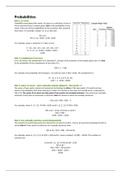Probabilities
Probability associated with events. An event is a collection of one or
more outcomes from a sample space. Rule 1: the probability of any
event is the sum of the probabilities of the outcomes that comprise
that event. For example, rolling 7 or 11 on two dice:
The sum:
P(7 or 11) = 6/36 + 2/36 = 8/36
For example, repair a computer in 7 days or less:
P = O1 + O2 + O3 + O4 + O5 + O6 + O7 =
0 + 0 + 0 + 0 + 0.004 + 0.008 + 0.020 =
0.032
If A is any event, the complement of A, denoted Ac, consists of all outcomes in the sample space not in A. Rule
2: the probability of the complement of any event A is:
P(Ac) = 1 – P(A)
For example, the probability of throwing {7, 11} with two dice is P(A) = 8/36. The complement is:
Ac = {2, 3, 4, 5, 6, 8, 9, 10, 12}
P(Ac) = 1 – 8/36 = 28/36
The union of two events contains all outcomes that belong to either of the two events. If A and B are two
events, the probability that some outcome in either A or B (that is, the union of A and B) occurs is denoted as
P(A or B). The union of an event can take place if two events are mutually exclusive. Two events are mutually
exclusive if they have no outcomes in common. Rule 3: if events A and B are mutually exclusive:
P(A or B) = P(A) + P(B) - 0
For example, when A = {7, 11} P(A) = 8/36 and B = {2, 3, 12} P(B) = 4/36:
P(A or B) = Union of events A and B =
P(A) + P(B) =
8/36 + 4/36 = 12/36
The notation (A and B) represents the intersection of events A and B – that is, all outcomes belonging to both A
and B. Rule 4: If two events A and B are not mutually exclusive, then:
P(A or B) = P(A) + P(B) – P(A and B)
For example, when A = {2, 3, 12} P(A) = 4/36 and B = {even numbers} P(B) = 18/36. The numbers in
common are:
(A and B) = {2, 12} P(A and B) = 2/36
P(A or B) =
P(A) + P(B) – P(A and B) =
4/36 + 18/36 – 2/36 =
20/36
, • The probability of the intersection of two events is called a joint probability
• The probability of an event, irrespective of the outcome of the other joint event, is called a marginal
probability
Joint probabilities
Marginal probabilities
Applying probability to joint events:
The joint probabilities of gender and brand preference are calculated by dividing the number of respondents
corresponding to each of the six outcomes listed above by the total number of respondents, 100.
P(F and B1) = P(O1) =
9/100 = 0.09
Computing the marginal probability:
The marginal probabilities for gender and brand preference are calculated by adding the joint probabilities
across the rows and columns. The event F (respondent is female) is comprised of the outcomes O1, O2 and O3,
and therefore:
P(F) = P(F and B1) + P(F and B2) + P(F and B3) =
0.37
Rule 5: calculations of marginal probabilities leads to the following probability rule. If event A is comprised of
the outcomes {A1, A2, …. An} and event B is comprised of the outcomes {B1, B2, … Bn}, then:
P(Ai) = P(Ai and B1) + P(Ai and B2) + P(Ai and B3) + …. + P(Ai and Bn)
The probability of occurrence of one event A, given that another event B is known to be true or has already
occurred. In general, the conditional probability of an event A given that event B is known to have occurred is:
𝑃𝑃(𝐴𝐴 and 𝐵𝐵)
P(A|B) =
𝑃𝑃(𝐵𝐵)
P(B1|M) = P(B1 and M) / P(M) = 25/100 ÷ 63/100 = 25/63 = 0.397
P(B1|F) = P(B1 and F) / P(F) = 0.09/0.37 = 0.243
We read the notation P(A|B) as “the probability of A given B.”
, Variations of the conditional probability formula:
P(A and B) = P(A|B) P(B)
P(B and A) = P(B|A) P(A)
Note: P(A and B) = P(B and A)
Extra explanation: Conditional Probabilities
When one event occurs, it may impact the probability of an event from a different experiment:
• The probability that a second event (B) will occur given that we know that the first event (A) has
already occurred A and B come from two different experiments (e.g. rolling die and flipping coin)
• Notation: P(A|B) “|” = “given” So, the probability of B given A is the probability that event B will
occur given that we already know event A has occurred
A: the event that Joint probability
has occurred
𝑃𝑃(𝐴𝐴 𝑎𝑎𝑎𝑎𝑎𝑎 𝐵𝐵)
P(B|A) =
𝑃𝑃(𝐴𝐴)
B: the event we want Marginal probability
the probability for
P(B|A) is equal to the joint probability of A and B divided by the marginal probability of A (= the
marginal probability of the event that already occurred).
Calculating the joint probability:
1. Find the joint probability of A and B (find corresponding row and column)
2. Find the marginal probability of the event that has already occurred (A)
3. Divide the joint probability by the marginal probability
Important note: look at the grammar of the sentence (e.g. “If we choose” or “We chose”) to define
what kind of probability you should use. With reservation/zonder zekerheid:
• ‘If we choose’ and ‘given’ is in the sentence: joint probability
‘We chose’ and spoken in the past: conditional probability
The conditional probability formula may be used in other ways. For example, by multiplying both sides of the
formula:
P(A and B) = P(A|B) P(B) = P(B|A) P(A)






